What to Wear After Knee Replacement Surgery: Comfort Meets Recovery
Before a knee replacement surgery, there are so many things to think about in order to make your recovery easier.
You will need equipment like a walker, crutches, shower chair, grab bars, and a firm chair that is easy to get in and out of.
Finding a good spot to prop your leg and sleep that is free of clutter, or stairs is also very important.
But have you thought about what to wear after knee replacement surgery?
For the first few weeks after surgery, you will have pain, swelling, and limited motion in your new knee – so wearing your everyday clothes will probably not be an option!
Especially if you normally wear tight clothing like me.
For most of us, getting all dolled up will totally be off the table.
But remember, you will still need to get up, get dressed, and go to physical therapy visits, doctor visits, and limited errands, so staying in your jammies won’t be an option.
So, what should you wear after a knee replacement?
My first suggestion is to look for clothes that are comfortable and easy to put on and take off.
First and foremost, you need to protect the incision site, so you will need to wear clothing that won’t irritate it and also allows you to bend and move comfortably.
This will be especially important when doing outpatient physical therapy and home exercises.
Pain and swelling are guaranteed after surgery, so you will need to wear clothes that allow for direct access to the knee for placing your ice packs.
Bending over to tie your shoes will be a challenge as well.
So, you need to find the perfect slip-on athletic shoe.
Recovering from knee replacement surgery can already be exhausting and grueling – don’t make it worse by not having the right clothes and shoes!
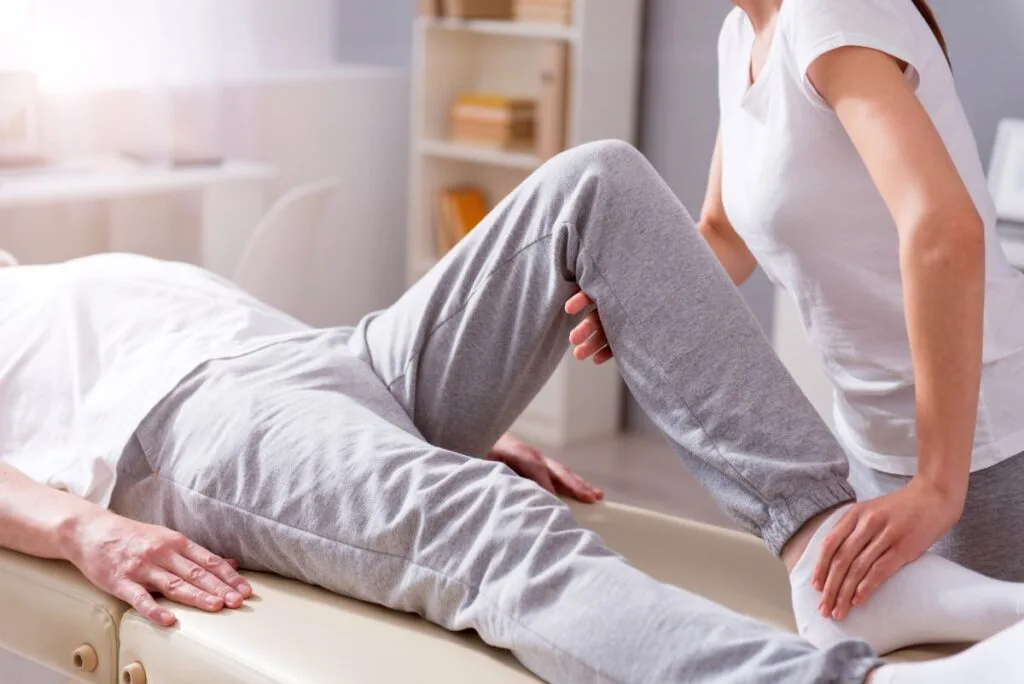
This post contains affiliate links. As an Amazon Associate, I earn from qualifying purchases. This means I may earn a commission at no extra cost to you, should you choose to make a purchase using my link.
Recovery Timeline after a New Knee Replacement
Most people are released to home on the day of surgery.
You will most likely have a nerve block during surgery, so the pain is not as severe for the first 12-24 hours.
Don’t let this fool you – the pain is coming!
At first, you will be taking pain medication regularly, and walking will be a challenge.
Don’t worry; after the first 3 months, you’ll be back up and running – OK, maybe not running – but getting back to your normal physical activities.
- First 6 Weeks: This is typically the most intensive part of your recovery. You will have your first physical therapy appointment the day after surgery. Your physical therapist will also give you a home exercise program to do which will suck! Pain and swelling of the knee and leg can be severe at first. You will also have staples, sutures, or surgical glue holding your incision line together, so it’s super important to wear clothes that don’t cover the knee or are loose-fitting and don’t rub and irritate the incision site.
- 6 Weeks to 3 Months: During this time, your incision site should be healed, and your range of motion should be almost back to normal. You may still have some pain and swelling, but this should be much better. Loose clothing at this point can still be very helpful, so you don’t restrict the knee. You should slowly be getting back to your normal daily activities by the end of this period or 3 months post op.
- 3 to 6 Months: By this time, you will probably be feeling more like your old self. Working with a physical therapist has probably ended by this point. You should be back to your normal daily activities and can now do low-impact exercises on your own. What you wear should not be a concern at this point.
Finding the Right Attire Post-Surgery
It’s all about comfort after knee replacement surgery!
The right clothes and shoes can make a world of difference, so let’s look at some must-haves.
Loose-Fitting Clothing
Try to find something loose in the leg so you don’t irritate the incision line. It will also be more comfortable with the swelling you will have.
My surgery was in November in the Midwest, so I lived in sweatpants.
But if you have surgery in warmer weather, I would choose shorts or a swing dress.
However, if you’re going to physical therapy, you may want to pass on the dress — you don’t want to show everything you’ve got!
Make sure that the waistband is loose since you will be sitting a lot, and you may have some stability issues at first when letting go of your walker or crutches while trying to go to the bathroom.
Nobody wants to be found in the bathroom with your pants half down!
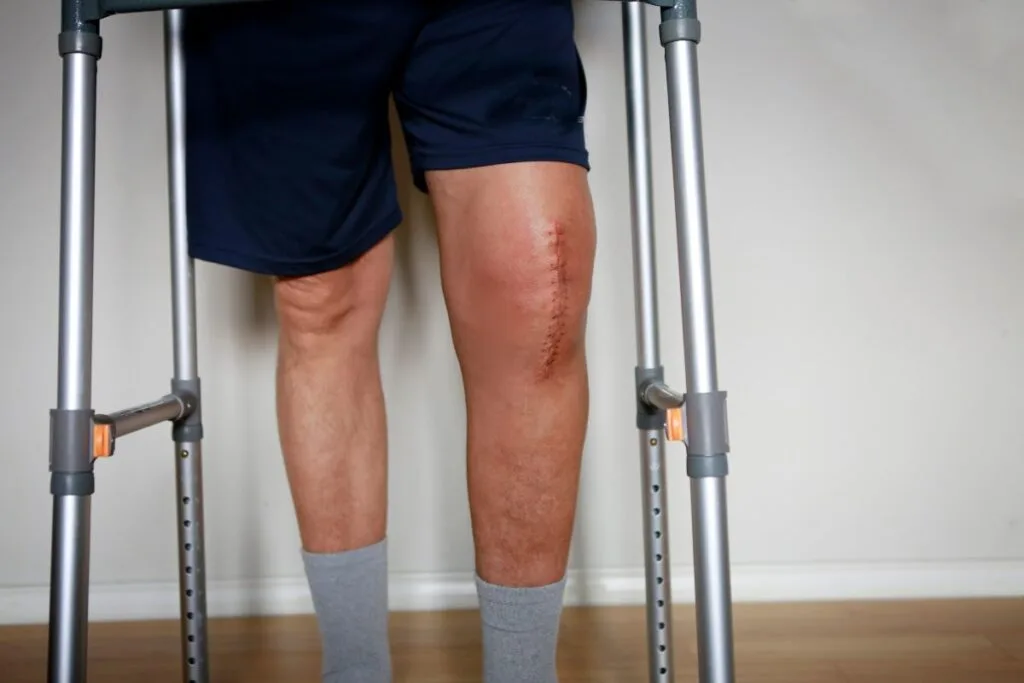
Best Shoes to Wear
Bending over and reaching your feet will be hard at first, which could make it impossible to tie your shoes.
So, it’s important to get the proper footwear to make your life easier after your knee surgery.
You certainly don’t want to wear dress shoes or high heels – keep those in your closet!
You won’t be steady on your feet for a few days to weeks, and you don’t want to fall on that new artificial knee joint.
The best shoes that you can wear after surgery would be slip-on shoes with a non-slip sole.
Try to find a pair of supportive slip-on athletic shoes – there are some cute ones out there nowadays if you’re a fashionista!
Also, be sure that they are comfortable to wear—you don’t need to create more pain after surgery.
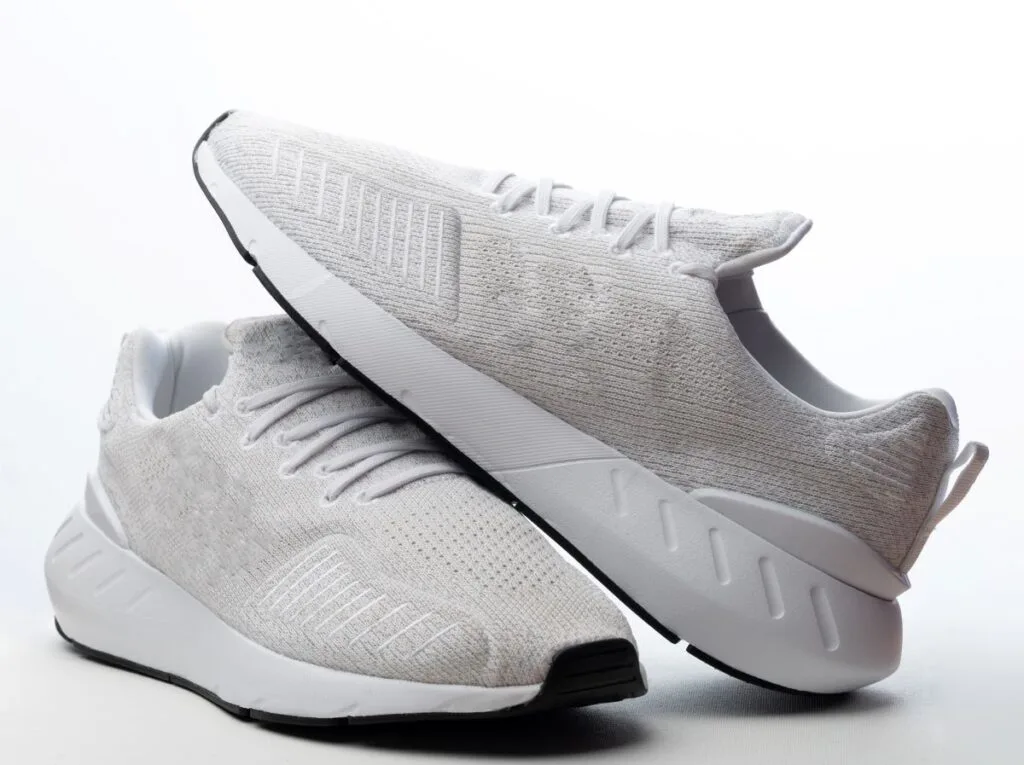
Do You Need Supportive Garments?
Your orthopedic surgeon will instruct you to wear compression stockings for a short amount of time after surgery to help with blood circulation to prevent a blood clot in the leg and decrease swelling.
I wore mine just for the first week. After you are up and moving your healthcare provider will probably let you discontinue them.
However, if you have other health issues you may be instructed to wear them for a longer period of time.
Items like knee braces are usually discouraged since they can delay strengthening your muscles around the knee.
So, if you are considering a knee brace from the drug store or that you wore prior to surgery, check with your orthopaedic surgeon or physical therapist first to see if they recommend you use it.
You don’t want to delay the recovery process.
Benefits of Breathable Fabrics
Breathable fabrics are important for comfort post-surgery.
Here are some options and why you should consider them:
- Cotton: Very absorbent and less likely to cause skin irritation.
- Bamboo: Naturally antimicrobial and soft, decreasing odor and discomfort.
- Linen: Super lightweight and gentle on sensitive skin.
Dressing Aids and Tools
If dressing yourself after surgery is challenging and you don’t have family members around to help you, I have a few gadgets that you may find helpful.
Sock Aid:
This simple tool helps you put on your socks without bending your knees too much.
Elastic Shoelaces:
Turn any lace-up shoe into a slip-on, so you won’t have to worry about getting your shoes on and off
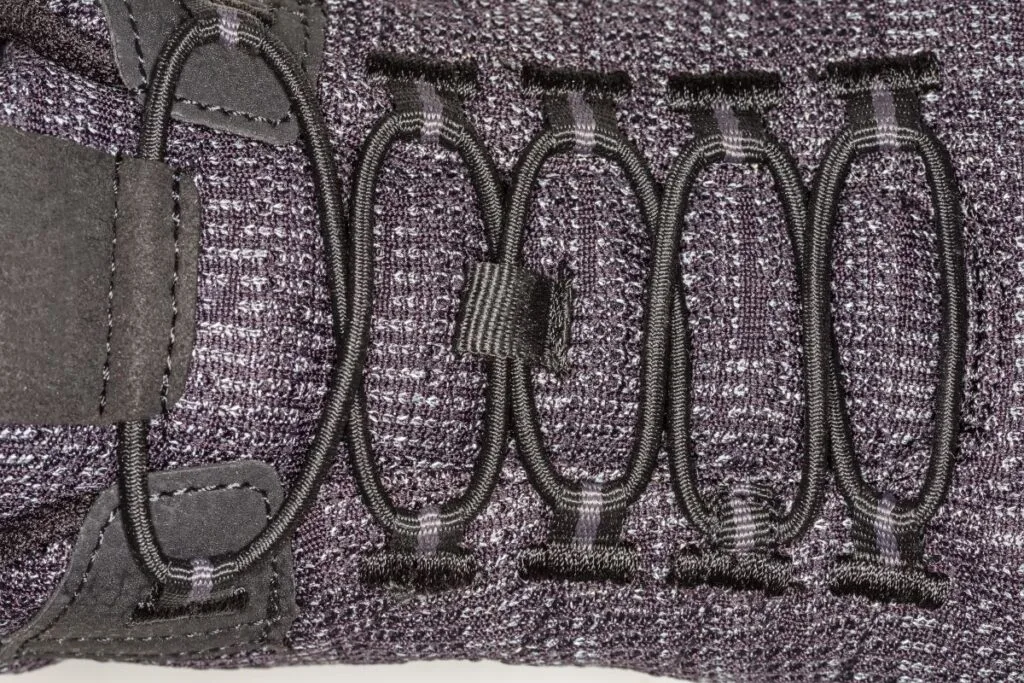
Dressing Stick:
A dressing stick has a hook on one end.
It helps you pull up your pants, skirts, or underwear.
Also, it is helpful for positioning clothes before putting them on
This can help you avoid bending your knees excessively.
Long-Handled Shoehorn:
A shoehorn with a long handle, can make slipping into shoes easier, keeping you from having to bend over and stress your knee.
You can also get all of these tools in one kit which could be cheaper than buying each item separately!
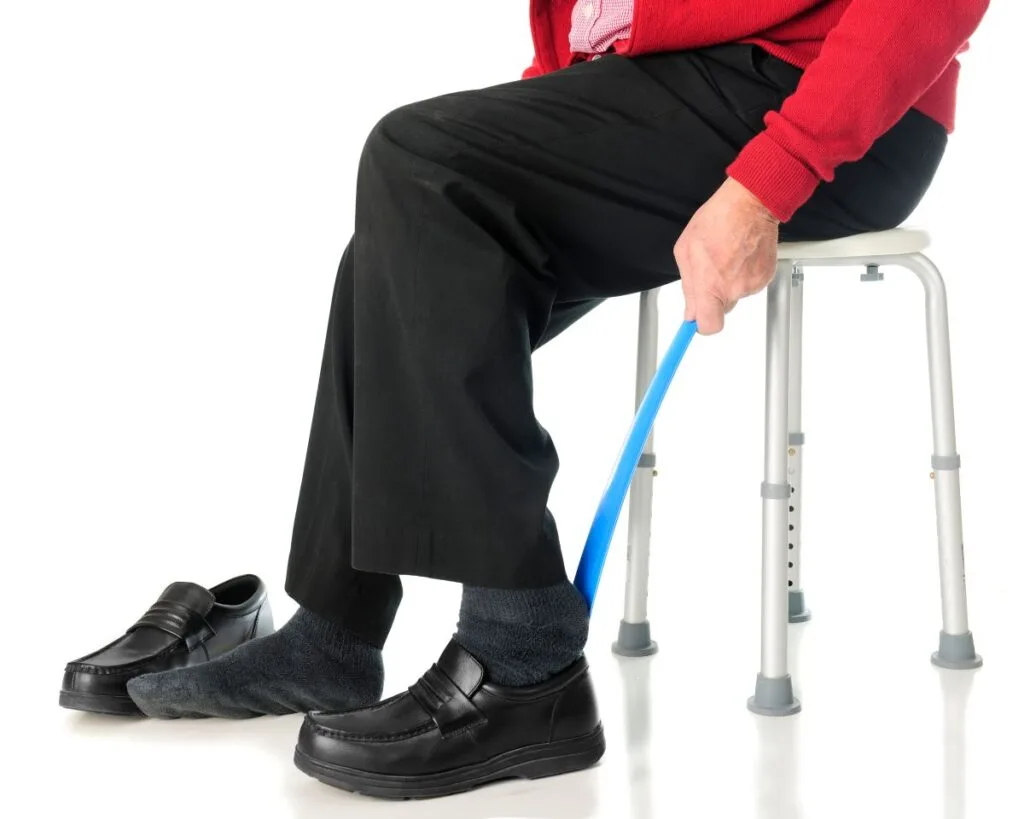
Considerations for Different Seasons
When you’re dressing after knee replacement surgery, it’s important to think about the seasons.
Summer Wear
During summer, you need loose-fitting clothes that are easy to put on and remove.
I personally think that summer is probably the best season for a knee replacement because you don’t have to wear anything that covers the knee.
Here are clothes to consider:
- Shorts: Shorts with an elastic waistband or adjustable drawstrings are best to get on and off.
- Skirts/Dresses: Choose loose-fitting skirts or a swing dress. They aren’t as restrictive and allow good airflow.
- Shoes: We all like the cute little sandals in the summer but be careful – slides, flip flops or shoes with slick soles can be difficult to walk in at first, and you could twist your ankle or knee or possibly fall! Not good dude!
Winter Clothing Options
Unfortunately, during the winter months, you will probably want to cover the knee because – well it’s cold!
I had my surgery in November in the Midwest, so it was cold – my go-to was sweatpants.
Here are some go-to clothes to consider:
- Pants: Avoid wearing tight-fitting pants. Think athletic pants like sweats or other pants that have stretchy material. This way they can move with you and can fit over your swollen knee and also allows room for your ice pack.
- Shoes: Be sure that you wear the appropriate footwear that are non-slip. A good fall on ice or snow can suck and really set back your recovery time!
What to Wear for Physical Therapy for Knee Surgery Recovery
For your outpatient therapy, you want to make sure that you are comfortable and can easily move your knee and leg—the looser, the better!
I would suggest athletic shorts or sweatpants with an elastic waistband that are wide through the lower leg and ankle.
That way, you can easily pull them up over the knee so that your physical therapist can see your surgical site or apply ice packs if needed during your physical therapy treatment.
I personally felt that physical therapy – like any workout – was all about the mindset.
You will work out harder if you are mentally prepared.
Even though I couldn’t wear my favorite yoga pants at first, I did wear all of my other workout clothes.
It helped me to put on my sports bra and tank top, which is what I normally wear when I work out.
You can also wear a loose T-shirt if you find it to be more comfortable.
I wore my favorite cute tennis shoes with non-slip soles.
Along with the clothes I wore, I also made sure to do my pre-workout and post-protein drinks.
This way I was mentally prepared to work hard and kick ass in my therapy sessions.
Also, make sure to wear lightweight, breathable fabrics like cotton or moisture-wicking materials to keep you cool and dry during workouts – because you will sweat!

What Should You Wear after a Knee Replacement
Choosing the proper clothing and right shoes after a total knee replacement surgery is important.
It’s all about the comfort and convenience during your recovery period.
Loose-fitting, comfortable clothing that allows you to move easily and doesn’t restrict blood flow which can increase your risk of blood clots are your best options.
Elastic-waist shorts, pants that are wide in the lower legs and ankles, or skirts that can be easily pulled on and off without flexing your knee to far are the best way to prevent increased knee pain.
Put away the cute flip-flops, slides and heels – find some cute slip-on shoes with a non-slip sole.
This is one of the most important things that can help you avoid falls.
Additionally, find clothes that give you easy access to the incision site in order to apply ice packs, do wound care and your physical therapy sessions.
Finding comfort after a knee replacement surgery is huge!
I would love to know what your favorite attire was during your recovery!
